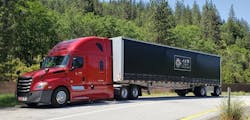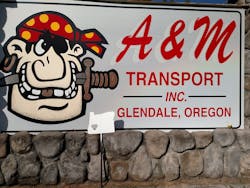Like many motor carriers, A&M Transport of Glendale, OR., spares no expense as it tries to recruit new drivers.
The 30-year-old, family-owned company works closely with driving schools, attends job fairs, advertises in newspapers, on the radio and across social media. A&M also is committed to hiring military veterans as part of the “Hiring 500,000 Heroes” initiative.
Despite the recruiting efforts, A&M Transport can't fill all of the open positions, so it turned to Visa Solutions to bring qualified drivers from foreign countries to the United States through existing immigration programs.
“We see this as a program with solid potential,” CEO Andy Owens told American Trucker. “It is not a 100% solution, but it certainly can fill a void.”
Founded 12 years ago in the Houston suburb of The Woodlands, TX., Visa Solutions has recruitment offices strategically located in Mexico, Poland, South Africa and the Philippines. Visa Solutions estimates it will bring 1,600 truckers from as many as 60 different countries to the United States during 2019.
As the demand for drivers continues to increase, Visa Solutions exhibited for the first time at American Trucking Associations’ Management Conference & Exhibition in October in San Diego.
A Visa Solutions' brochure listed about 30 trucking companies, including A&M Transport, that are clients. Attempts to contact many of these fleets were unsuccessful, similar to what American Trucker's sister publication Fleet Owner experienced in 2017 when it looked into the process of recruiting immigrants.
Regardless of the reasons behind that silence, Marketing Director Daniela Garza stressed Visa Solutions is an American company whose goal is to “help the U.S. economy,” while giving back to less fortunate countries across the globe.
Temporary or seasonal workers from foreign countries come to the United States through the H-2B program, run by the Department of Labor and Department of Homeland Security. These employees work during peak periods, and then return to their home countries.
Motor carriers, which require year-round help, can hire drivers through the EB-3 program, which allows qualified foreign workers to obtain permanent resident status in the United States under certain conditions.
Owens said A&M was among the first fleets to work with Visa Solutions, which navigates the “frustrating process” as the federal government carefully reviews each applicant. The approval process can take up to 14 months, and Visa Solutions said it oversees the entire process.
A&M thus far has brought two drivers to the United States from Mexico, and there are 13 others waiting for final federal government approval.
The younger of the two drivers had more than 15 years of documented safe, professional driving experience and is in his mid-40s. He has already brought his immediate family to Oregon, and the other driver expects his wife to move to the state before the end of the year.
Owens emphasized they are viewed as “regular” drivers, and receive no preferential treatment. From job responsibilities and performance expectations, to health insurance and tax withholdings, they are equal to every other A&M driver. That includes starting pay, which is on par with U.S. drivers joining A&M with similar experience.
Garza said only the top 1% of workers that apply are accepted into Visa Solution’s program. Criminal background checks, reviews of driving histories and in-person interviews are all part of an exhaustive approval process. They are required to speak English and commit to at least a three-year tenure.
Even for those who initially qualify, Garza said it is up to each fleet to set the individual parameters for the drivers they are willing to hire.
Bob Costello, ATA’s senior economist, said the need for fleets to look outside the United States to fill driving positions indicates “how much they struggle” to find qualified drivers.
Costello dismissed a question about whether seeking foreign workers was more about finding cheaper labor. “It is much easier to hire drivers already here,” said Costello, adding that “by no stretch will immigration solve the driver shortage.”
A&M’s Owens said he expects more fleets to consider foreign workers as they learn the details of the visa program.
“I’ve described the program to lots of people and I haven’t had a single negative comment about it yet,” said Owens. “They are sitting back and asking, ‘where’s the catch?’ ”
His response: “There is no catch.”
Owens’ view has been shaped by more than just the performance of the two Mexican-born drivers already behind the wheel. He shared that one soon-to-be driver waiting on final approval from the government recently popped into A&M’s headquarters on his own, simply to feel he is already part of the company.
Garza shared a similar message, saying the gratitude these foreign workers have for those willing to take a chance on them usually leads to successful, long-lasting relationships.
“Most of my trucking friends will tell you that 5%-15% of their trucks are parked right now,” Owens said. “I think this can be a solution that can get them out on the road and rolling.”






